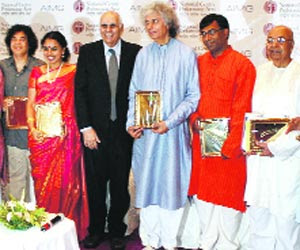Leading maestros comprising the All India Musicians’ Group (AIMG) meet at Mumbai’s National Center for Performing Arts on July 10 to address key challenges facing Indian classical music. Attended by the who’s who of Hindustani and Carnatic classical music - M Balmuralikrishna, Pt Ajoy Chakrabarty, Pt Hariprasad Chaurasia, Ustad Zakir Hussain, Pt Sajan Mishra, Arvind Parikh, Sudha Raghunathan, Chitravina Ravikiran, T V Sankaranarayanan, Pt Shivkumar Sharma, U Shrinivas and Ashok Vajpeyi.
The National Centre for the Performing Arts, Mumbai - India’s premier cultural institution - and the All-India Musicians’ Group (AIMG) thus came together today to conduct a landmark event in the history of Indian music. Some of the country’s most renowned and reputed musicians gathered to discuss and address the current state of affairs of classical Indian music.
The primary objective of the NCPA and AIMG in initiating this gathering of the country’s leading maestros on one platform was to review the current Indian music scenario and to be a voice in unison with great national musicians expressing their views.
To make the occasion even more memorable, the NCPA presented Honorary Life Membership to all the AIMG members and patrons, as a tribute to their contribution to promoting and preserving the heritage of Indian music, not only in India but also globally.
Honouring the musicians on behalf of the NCPA, K N Suntook, Chairman, said, “We are indeed proud to have the icons of Indian music with us as an integral part of the NCPA family. I am certain that this alliance will help us attain our common goal of providing a platform for talented Indian musicians and supporting this movement in myriad forms.”
Some of the significant topics discussed at the meeting included the teaching of music to students at school level as well as further highlighting the need for support from the Ministry of Finance and Cultural Department to provide active encouragement to the Indian classical music fraternity. Additionally, the meeting featured the NCPA’s on-going efforts in promoting and preserving Indian music and other art forms, as well as ways in which the NCPA and AIMG could work together to champion the cause of Indian music.
Arvind Parikh, Convener - AIMG commented, “The All-India Music Group (AIMG) is a representative body of Indian music, comprising the leading maestros of both the Hindustani and Carnatic music systems. AIMG believes that the direction which Indian classical music is being induced to take requires corrective measures and it is the mission of AIMG to strive through interactions with all concerned to ensure that the focus of Indian classical music stays true to its authentic and time-tested objectives.”
Said K.N.Suntook, “We have come together to discuss and address the challenges facing the preservation and promulgation of the incredibly diverse schools of music with which India is blessed. The challenges include convincing the government, large corporations and educational institutions of the importance of preserving this rich heritage and not relegating it to be of less priority than the undoubted human and infrastructural problems that face our country.
“Whenever we approach Government for any meaningful aid or assistance, we are told that on account of the impact on revenue, they regret their inability to help. This is in deep contrast with the assistance provided by Asian countries to nurture and develop not only their own forms of art but also great international art. Singapore is a fine example of the success it has made after it developed the iconic Esplanade.
“In India, support of the Performing Arts features very low in the corporate social responsibility of even some of our most enlightened and richest corporations. How can we change that? Even purely as a business and as a means of attracting tourism, the great potential of using music to attract not only audiences within India but also from foreign shores has not been properly thought through, and even the tip of the potential of our huge cultural iceberg lies dormant. Countries with great historical and cultural traditions, whether they are in the form of architecture or the performing arts, have drawn on their treasures by first ensuring that the local population itself is educated and encouraged, in schools and at home, to understand and inculcate great pride and pleasure in preserving their heritage. Italy is a fine example, as are even small countries like Austria where the famous Salzburg Festival and even dozens more all over Europe and now even Asia, draw huge audiences filling their airlines, their hotels and nurturing the tourist industry. Tickets for many of these Festivals are sold out years in advance. Imagine what we could do if we structure education, promotions and understanding of our art to attract even a fraction of our huge population.
Adds he, “I believe it would refine our taste, improve our value systems, and unify our people. This is the challenge facing us and this great group are eminently qualified in addressing them. I can assure our Indian music community that within the resources available with NCPA, we would not be found wanting.”

0 comments
Post a Comment